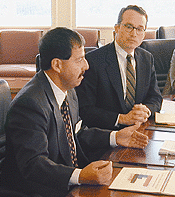Rise in Short-Haul Could Change the Demand for Trucks
 | |
| More coverage | |
| |
 |
“When you are considering why some of these orders for equipment have been put on hold or in some cases canceled,” he said, “I think it’s because people are looking at the fact that the short-haul business has grown at two-and-a-half times the rate of their long-haul business and that’s going to need a different piece of equipment.”
Scherck said companies may turn to used Class 8 trucks intended for regional or long-haul service rather than vehicles designed for short-haul work because the former are available at low prices.
For example, a 1997 Kenworth T2000 can be purchased used for between $59,000 and $74,000, depending on its condition and features. The baseline price for a T300 medium-duty vehicle from the same manufacturer runs $43,000 for a 2000 model.
With expectations of selling a historic high of 260,000 units in 1999, truck orders have started to fall and cancellations have risen as 2000 gets under way. It has led two major manufacturers, Volvo and Navistar International, to announce production cuts and Freightliner to discontinue all Saturday overtime ("Truck Makers Set Production Cuts ," 1-10, p. 1).
According to Stark’s Truck & Off-Road Ledger, a newsletter that monitors some aspects of heavy manufacturing, cancellation of truck orders had risen to 36% by the end of 1999 and the backlog of orders had fallen to 189,025 units, compared with 257,925 at the close of 1998.
Scherck’s comments drew disagreement from two other panelists at Transport Topic’s annual management forum — Donald Broughton, a senior analyst of transport equities for A.G. Edwards & Sons in New York, and John Smith, president of motor carrier CRST International in Cedar Rapids, Iowa.
 Michael James - Transport Topics |  |
| Ted Scherck (left) of the Colography Group and Donald Broughton of A.G. Edwards & Sons discuss the trends in the Class 8 truck market. |  |
Smith concurred, saying lower used truck values would cause his company to lengthen its replacement cycle.
Scherck described a trucking world shaped like a barbell, in which the fastest-growing end is short-haul, small shipments from distribution centers of online merchants like Amazon.com. At the other end is the long-haul business, which is growing at a slower rate. He said the center bar is made up of the shrinking category of medium-range hauls of between 700 and 1,200 miles.
The Colography Group executive thinks that trucking companies are “evaluating where they are going to be in this new business model and that will impact what type of equipment they buy and when they buy it.”
Scherck said an acceleration of orders for Class 5 to 7 trucks had not occurred because the acquisition cost was low for bigger equipment, such as used Class 8s. He added that the bigger rig was being used in many situations where it wouldn’t be economically justified.
“I think it’s going to take some time for that to work its way out of the economy,” he said. “When those trucks break, they [the owners] aren’t going to replace them with that size equipment; they’re going to replace them with equipment that is better suited to the job they are doing.”
However, after some discussion, Scherck noted that he was not talking about equipment configured for smaller loads, but rather for shorter hauls, which could include the use of Class 8 trucks.
Broughton and Smith offered more conventional views on the outlook for big truck sales in 2000.
“You aren’t going to go buy a new truck if you can’t find a driver to put in the seat,” Broughton said of thinking among motor carriers.
 |
The poor condition of the used truck market might have discouraged mergers or acquisitions, which can result in 30% to 40% of the drivers leaving for various reasons. Such a big lost of truckers might force the buyer to dispose of 30% of its fleet, Broughton said.
“If the used truck market is weak, then they are hard-pressed to make the numbers work.”
Smith said the price of a used truck fell 50% between the time his company ordered a new rig and the time it arrived. He said CRST is dealing with the used truck problem by making them available to company drivers who want to become owner-operators as an alternative to writing the vehicles off.
“We couldn’t afford to take that hit on the balance sheet.”
Smith said the low used truck prices would definitely lengthen his company’s trade cycle to four years — up an extra year. He cited such action as a reason for canceling truck orders.

